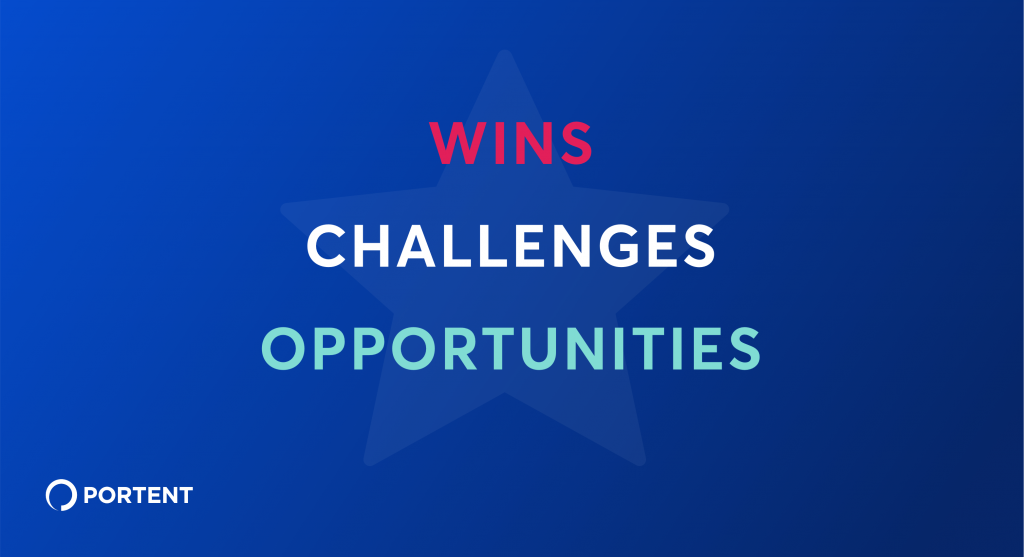In today’s business world, you likely already know what a quarterly business review is. However, I find that too often, people either don’t do them right or they don’t do them at all. If you aren’t having an honest conversation with your clients about how work is going or if it continues to be the right work, you may be setting yourself up for failure.
In my 11+ years of agency experience, whenever a client is unhappy, the first question I ask is, “When was the last time we had a QBR?” It’s an important time to break out of the day-to-day and standing meetings. QBRs give you the chance to pull back from the minutiae and look at the big picture. Taking the time to do this will ultimately benefit both you and your clients.
What Is a Quarterly Business Review (QBR)?
A QBR is a company or group’s chance to analyze its work from the previous quarter. By looking at the work’s impact on hitting existing goals, a company can determine what challenges they encountered and what opportunities they found. The plan for the next quarter should use these insights.
Why Are QBRs Important?
I get a lot of questions here at Portent, and: “What defines a good quarterly business review?” is probably near the top. Another version of this question is, “Do we need to have QBRs?” I have only one answer: “Damn right, you do!”
Showcase Value
So, why are QBRs so important? Because a good QBR shows value. Value in work done. Value in the relationship. Value in the time and money that you’ve spent! Your teams have dedicated countless hours working hard to deliver on the client promise, and now is your time to highlight the fruits of your labor.
Plus, you never know who might show up to your QBR. If a Director, VP, or C-suite stakeholder who rarely attends your weekly meetings should participate in this meeting, invite them! We’ll get into tailoring your QBR for a broad audience later.
Note: If a project or phase is ending, and you want to report on how things went, you should consider running a post-mortem or retrospective.
Track Overall Success Metrics
QBRs are also a critical time to reflect on the work. How did your strategy and tactics perform? Let your audience know if something went well and why. Did something fall flat on its face? Tell your audience why it didn’t work and what you learned.
Early-Warning Signals
Was there a project delayed or depreciated due to roadblocks? Use your QBR to bring light to these issues. You were hired to do something; if something is in your way, be frank about what you need to complete the work.
Alignment (or Realignment) on Goals
Finally, these business reviews are a time to evaluate the project’s scope. If your team realizes that a small or large pivot is needed, this is the time to say so.
What to Include in a QBR?
Over the years, we have tweaked what to include in a QBR. Though we have adjusted our language to describe the work, the ultimate goal is to report on what we did and how it went. Our new presentation format contains the following steps:
- Executive Summary
- Goals
- What We Learned
- Next Steps
- Roadmap
- Appendix
1. Executive Summary
At Portent, we start our QBRs with a high-level summary of essential topics. If we have something to celebrate here, we’ll say it. If something didn’t go as expected, we’d mention it here too. Don’t bury the lead in the 20-40 slides that follow. And please, please ensure that the main takeaway of the QBR is bolded for emphasis.
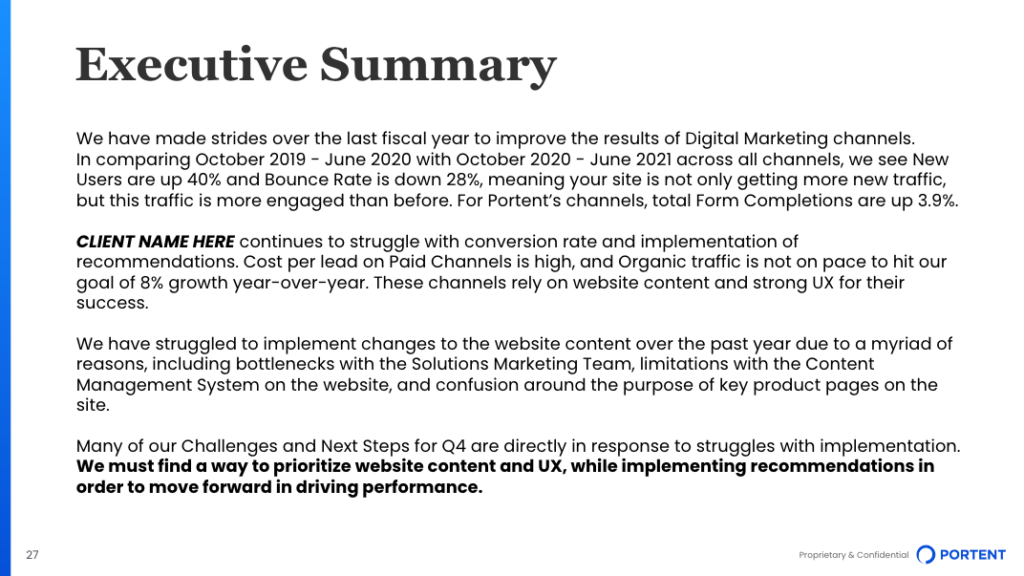
2. Goals
In this section, we use two slides to reaffirm the goals that we are working on for our clients. The first slide shows our high-level goals in plain language. We may have specific KPIs that may fall under each category, but this section is for your daily contacts and high-level ones.
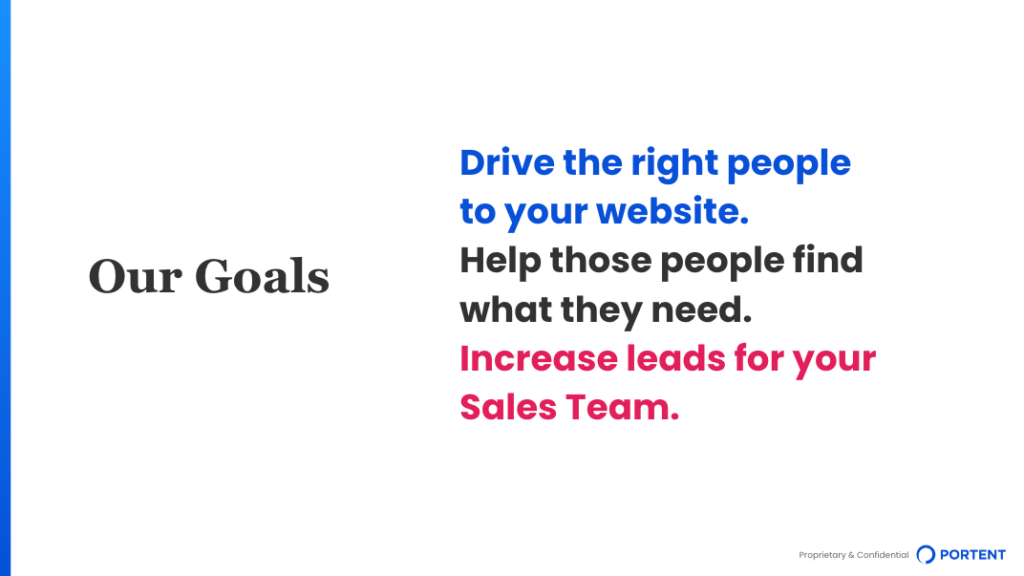
Our second slide explores how we can affect these goals as a marketing agency. For example, increasing leads for your sales team is something we can only partly affect. We can’t control how a client’s sales team qualifies leads. We can, however, influence conversions. So for clients with goals we can’t influence directly, these two slides are critical to ensuring they understand what we can affect and how we help them meet their goals.
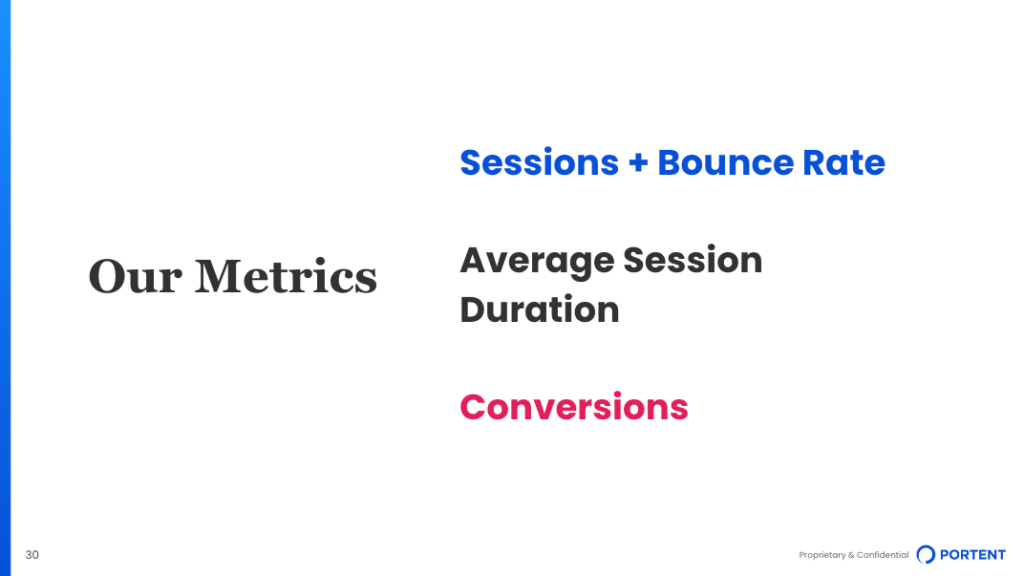
3. What We Learned
In the “What We Learned” section, our team looks at our roadmaps, projects, and initiatives to see how they performed. We describe projects important to your work. You should identify them by name, when the project ran, what you did, and why you did it.
We highlight this project information in our first slide:
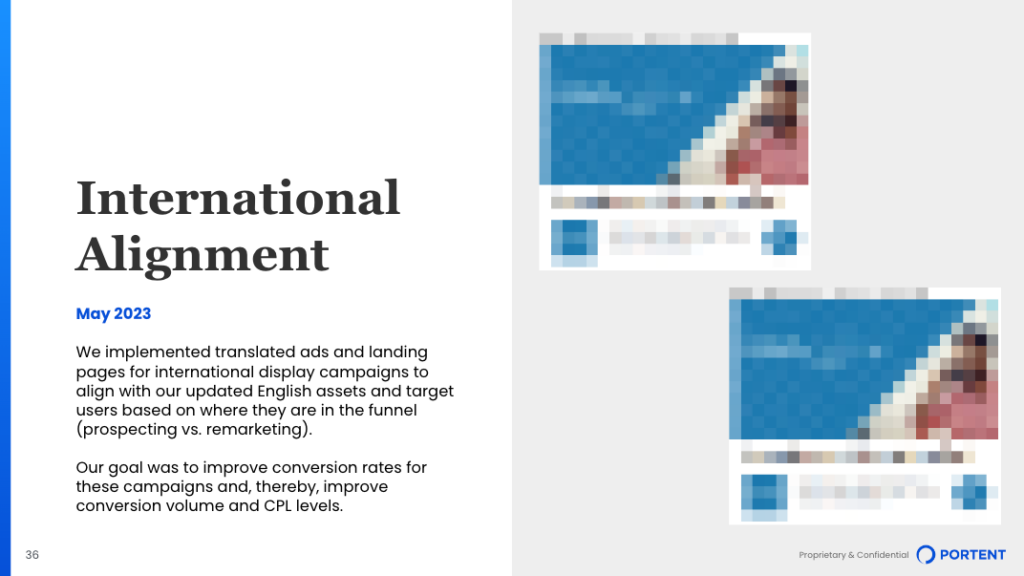
As a follow-up, the next slide presents the supporting data. Ideally, you’ll have a graph line going straight up and to the right. But we’re looking for any data that shows why we’re highlighting this project. We’re big advocates for data visualizations here. So whether the data indicates a clear win, a near loss, or something that needs additional time, show it here.
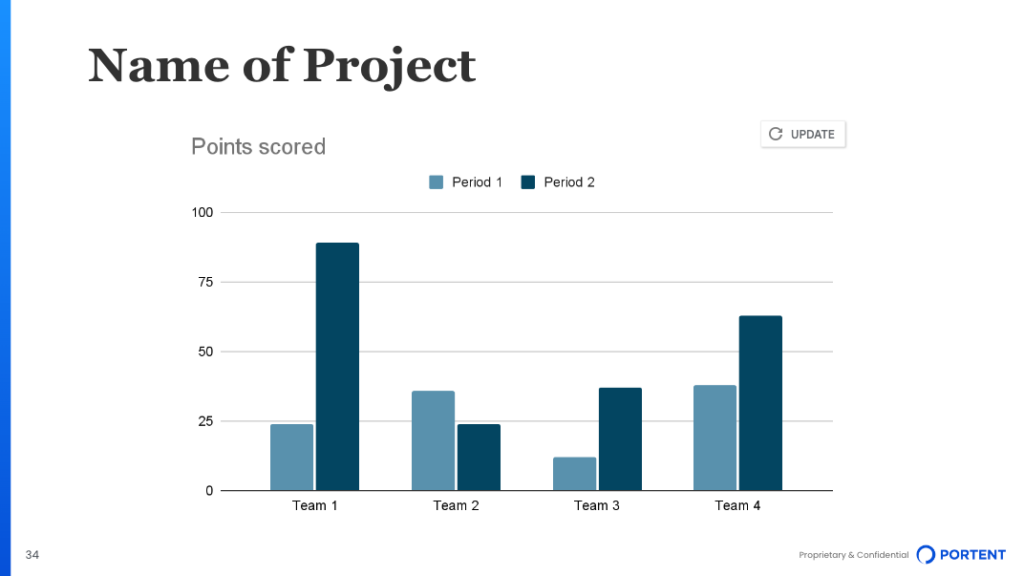
Finally, it’s time to discuss the takeaways from this project. Deliver your observations and what you and your team learned from your project. However, you must include an explicit “so what” and “what’s next” here.
Highlighting your work without saying why it’s crucial wastes your time and your client’s.
Instead of saying, “Bounce Rate went down,” consider saying, “Bounce Rate has decreased since we deployed our new content on these pages. We must continue this project and recommend revamping an additional 20 pages.”
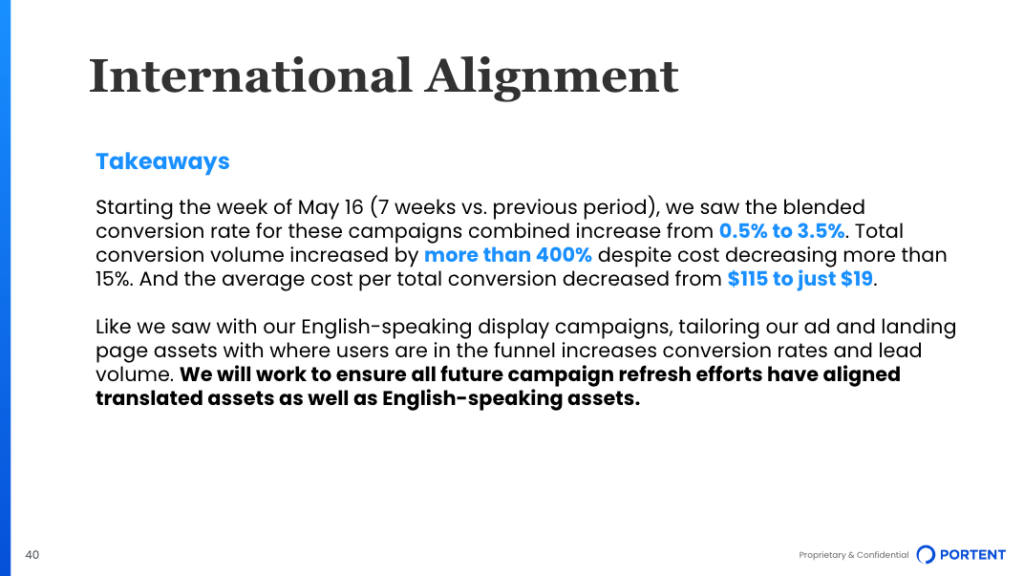
4. Next Steps
With the information from your learnings section, it’s time to present your next steps. We break these down into three sub-sections, what we’ll keep doing, stop doing, and start doing.
Each current process or project should have its slide, and you can combine like topics if you recommend keeping, stopping, or starting them as a whole.
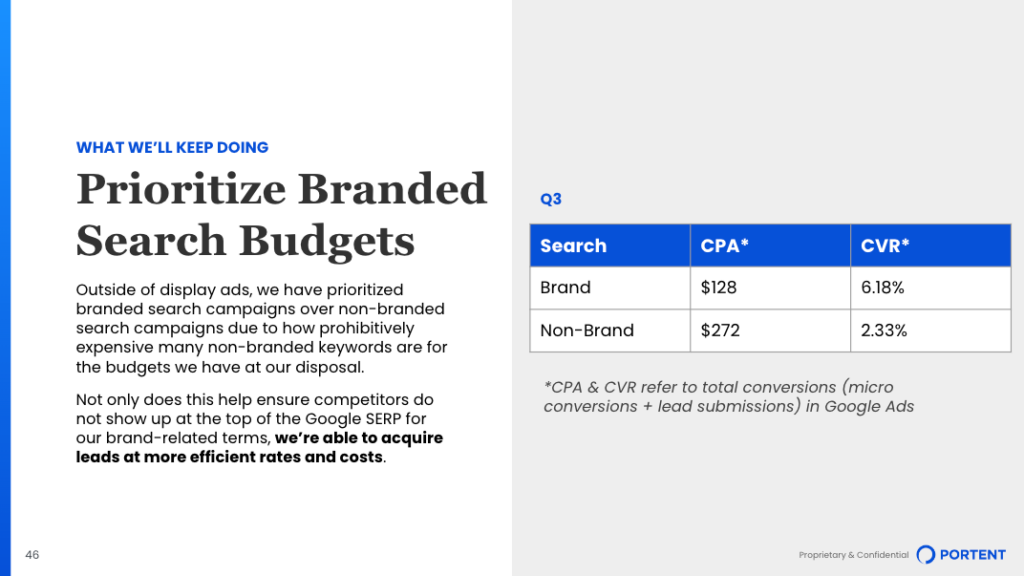
1. What We’ll Keep Doing
As mentioned, our “What We’ll Keep Doing” slides highlight your successes and why they’re essential. For these slides, call out:
- What did we do?
- Why was it successful?
- Why will we keep doing it?
- How will we keep doing it?
Bolding the one phrase that you want people to remember from this slide.
2. What We’ll Stop Doing
In your “What We’ll Stop Doing” slides, it’s time to be honest partners and call out what didn’t work. Whether the work was a legacy holdover that the client was working on or something you recommended, if it isn’t working and you need to pivot, here’s your chance to say so. For these slides, we suggest the following information:
- What did we do?
- Why wasn’t it successful?
- What will we do instead?
Again, bold the one phrase you want people to remember from this slide.
3. What We’ll Start Doing
Use the “What We’ll Start Doing” section to call out net-new suggestions based on learnings or as pivots away from tactics in the “What We’ll Stop Doing” section. For this section, the process looks like this:
- What do we want to do?
- Why do we want to do it?
- How will we do it?
- Bolding the one phrase that you want people to remember (are we making this clear enough?) from this slide.
5. Roadmap
This section can and should incorporate items from your Next Steps part of the presentation. I’d say that this can be a high-level snapshot of the work you’d like to do in the next quarter. You may have a more tactical, existing roadmap, but you can paint in broad strokes for this broader audience.
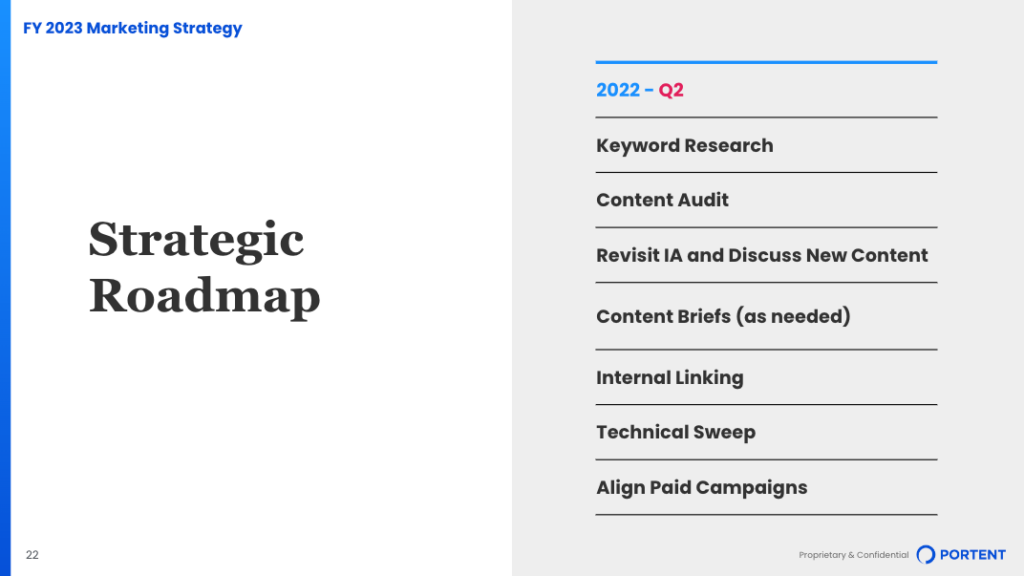
6. Appendix
Depending on how you run your presentation, you can add or remove this section. We use this section to link to data that would otherwise crowd out important messaging.
Again, with attendees ranging from in-the-weeds to once-a-quarter, some may demand a complete explanation, while others may be content to move on.
How to Prepare for a QBR?
While there are many ways to prepare for a QBR, at Portent, we encourage our teams to be proactive in planning these meaningful discussions.
Previously, we’d ask folks to come to these meetings ready to talk about what they’d done in the past quarter. The hope was that discussion would spark ideas in others and that a beautiful freeform, brainstorm session kind of jazz would happen, with folks layering on their parts. Sometimes, it works that way, and it’s lovely. And… sometimes it doesn’t. Especially once remote-first and hybrid work became the new reality. So now we do it a different way. Now we have our team fill out a spreadsheet before we meet.
One Month Out – Ask Your Team to Fill Out Their Notes
About a month before your QBR, send a notes spreadsheet to your team. Ask them to fill in their What We Learned and Next Steps sections. These ideas and topics don’t need to be fully fleshed out, but each team member needs something to bring to the brainstorming session.
Three Weeks Out – Hold a Brainstorming Session & Assign Slides
You should hold your brainstorming three weeks out, provided you have a completed spreadsheet. I’d highly suggest you look at the sheet in advance. If it’s not ready, do not hold your brainstorm: you’ll waste your time and your team’s.
Once prepared to meet, ask that your team read their ideas out loud. The idea here is to have people in different areas recall all the work they did in the past quarter. Though teams may operate in their silos, the reality is that there’s a ton of cross-team collaboration that happens.
As an example, most PPC campaigns have analytics or content support attached to them. And that same campaign may have an organic counterpart. If so, is there a way to highlight this as a larger, holistic initiative in one series of slides? Look for common themes here and dig in! If an initiative worked in one area when it didn’t work in another, can you and the team determine why? Do you need to shift resources from one channel to another?
Once you have your ideas fleshed out, determine who will create these slides and assign them. Again, using the PPC/Analytics example, you can have your PPC specialist as the primary slide creator, with your analytics team completing them by creating supporting graphs or images.
Two Weeks Out – Schedule Internal Delivery Date & Practice Presentation
Schedule an internal slide delivery date. We typically ask that our teams deliver their slides to the account manager two weeks before the final presentation. Ensure that your team’s slides are rooted in the client’s vocabulary, and tie tightly back to your client’s goals and KPIs. Don’t just add sexy numbers. Show your client the “so what?”
Next is your internal team presentation, which is your chance to give your QBR a dress rehearsal. Your team should be prepared to speak to their sections. We also suggest involving senior leadership or other stakeholders from your agency or company. These additional eyeballs provide an objective perspective that ensures your presentation delivers on your company’s promise. Implement any final feedback following this meeting.
One to two Days Before the QBR – Send Your Presentation to the Client Early
Send your deck to the client contact. Sending it early serves two purposes. First, it allows you to ensure that you have covered all angles. Your primary stakeholder may ask that you cover additional topics or clarify existing ones. Second, should you be presenting remotely, they’ll have it if your connectivity goes down.
Day of the Presentation
You will likely want to schedule 90 minutes for the presentation. The first 60 will be for the QBR itself, while the remaining 30 will allow plenty of time for Q&A.
That’s All, Folks…? – Send Follow Up Notes & Assign Tasks From Roadmap
You’re not done just yet. Be sure to see if your client has any edits to the presentation. Within a week, it would be helpful for you to update your deck and send them the final PDF for their records. Don’t forget to assign all tasks from your roadmap.
QBR Best Practices & Advice
If you take nothing else away from this article, please take note of the following advice to create an engaging QBR presentation. This is your chance to say the things you need to say. If things are going swimmingly, let people know what you did and why it worked! And again, if something is getting in your way, DO NOT be shy in identifying what it is.
Have an Opinion
As we like to say around here if you’re showing numbers or a graph on a slide to someone, you better have either a “so what” or a “why does this matter” statement attached to it. Your QBR is your chance to be honest about progress and the road ahead. Even if your “hot take” may be unsettling for some, you are the expert here. Say what needs to be said.
Executive Summary = TL;DR
Again, don’t shy away from showing your cards right at the top of the presentation. Summarize what went well and what didn’t. Some QBRs can reach up to 90 slides, so call it out in bold if you need your client to hear an all-encompassing theme or issue. Remember, have an opinion, and don’t bury the lead.
Have Fun
If you’ve built enough trust and rapport with your client leading up to your QBR, you should give yourself a little free reign to have fun with your presentation. Don’t go overboard, but if your gut tells you that one animated gif or funny photo will get the point across, give it a try. You might just see a smile or two.
Portent’s Free Quarterly Business Review Template
Ready to up your quarterly business review game? Check out Portent’s QBR Slide Template to get started!
Final Thoughts
In my experience, I’ve found that sticking to this schedule and format has made for some transcendent QBR conversations. The “What We’ll Stop Doing” and “What We’ll Start Doing” sections allow you and your client to discuss what fine-tuning your relationship needs, and you’ll both be better for it.
Moreover, don’t forget to take credit for the beautiful work you’ve been doing. Your Quarterly Business Review is the perfect time to show the value you bring to your client.
The post How to Perform a Quarterly Business Review (QBR) in 2023 (w/ template) appeared first on Portent.

